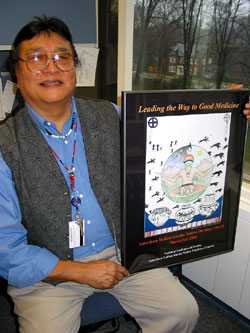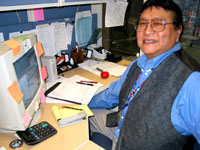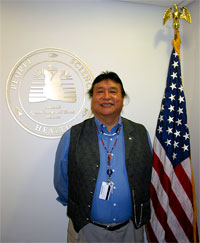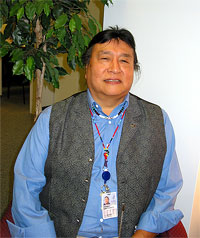 |
 |

|
|
Frank GrayShield, M.P.H., holds a poster that commemorates the American Indian and Alaska Native Heritage Month observed in November 2001.
|
1. Introduction...
2. I chose this career because...
3. My typical workday involves...
4. What I like best and least about my work...
5. My career goals are...
6. When I'm not working, I like to...
|
|
1. Introduction...
|
Back to Top

|

|
|
Mr. GrayShield sits at his desk, where he accomplishes many of his communication tasks
|
Before beginning, let me introduce myself in English in the traditional American Indian way:
“Greetings. My name is Frank L. GrayShield. I am a Washoe from Nevada. My clan is the Redfox Clan. My tribe's homeland is the lands surrounding Lake Tahoe in Nevada and California. I grew up on the Quechan reservation, Fort Yuma, California and, I am a Navy Veteran.”
|
|
2. I chose this career because...
|
Back to Top

|
I chose to become a health educator because of a combination of events and people that influenced me throughout my life. The following key individuals role-modeled good work ethics and influenced me to choose a career that would allow me to be creative and innovative with many rewarding experiences. Women in the family were also key influences that motivated us to be the best we could be. Also, the military experience gave me the self-discipline I needed to be responsible for my actions.
My Father
I would submit that it is important to have role models in one’s life who have good work habits coupled with steady jobs that allow one to support one’s family. Such is the case with my father. He worked and retired as a lineman for Sierra Nevada Power Company. My grandfather was also a good role model. After school no longer interested me, I dropped out as a junior in high school and joined the Navy. While in the Navy, I was trained and worked as an air traffic control (tower) operator. After my enlistment, I completed a general educational development (GED) program that enables adults to earn their high school diploma. My first noteworthy job (interestingly, similar to my dad’s) was as a telephone installer with Nevada Bell in Carson City, Nevada. That is when I realized the “dividing line,” that is, the difference between people who had a college education and people who did not. Linemen and phone installers who had worked for the same company for years could only advance to a supervising foreman position; any position beyond that required a B.S. degree.
My Grandfather
Wanting to try something new, I moved back to the reservation where I grew up and went to work in the off-reservation town of Yuma, Arizona. I got a job at the local newspaper as a printer’s apprentice. My grandfather had retired earlier from this same newspaper. He operated a Linotype, which is a typesetting machine, with a keyboard, that creates a lead mold of words in sentences in columns of lead type. These machines are no longer used for printing; there is one on display at the Smithsonian Institute in Washington, D.C. (Learn more about the Linotype machine at http://americanhistory.si.edu/youmus/ex25prgr.htm.)
My grandfather was a good role model because he worked consistently for 30 years at the newspaper and provided a comfortable life for his family. Unfortunately, since his work did not require physical activity and he did not engage in regular exercise, eventually his health suffered. In his later years, he developed diabetes. Living on the reservation in the early years (1942–1950, plus or minus a few years), I recall that we didn’t have electricity, telephones, or running water. We didn’t know about the importance of the long-term health benefits of good nutrition and regular exercise; we were meeting our basic survival needs. Health education was limited to what information you got when you were sick enough to have to go to the Public Health Service Indian Hospital. At that time, many people only went to the hospital when they were so sick or hurting so bad that they often died, so nobody wanted to go to the hospital. Lacking an effective community health education outreach program, we didn’t realize we were at greater risk to develop diabetes, especially, since our diet tended to be high in carbohydrates, salt, and sugar (filler foods and sweet drinks). Obesity tended to be looked on as a natural progression as you got older.
From Barber to College Student
I decided that printing work was too sedentary and did not provide an interesting enough future opportunity for me. Again, I could not see working for 30 years with only the possibility of attaining the level of foreman. So I took advantage of a vocational training program offered by the federal government to members of federally recognized tribes, and became a barber. I liked working indoors in a comfortable climate and interacting with others. I used to cut the hair of young American Indian students who were enrolled at the Northern Arizona University. Many of these students were repeat customers. I saw them complete their education and get good jobs with good pay. That inspired me to apply for acceptance at the nearby University of Northern Arizona.
At the age of 29, I went back to school and earned a degree in psychology with a minor in sociology. I chose these subjects because I believed I had natural skills in these areas and could successfully compete with other students.
After completing undergraduate school, I returned to Carson City, Nevada, where I served 1 year as the health director for the Washoe tribe, and then served 4 years as the Carson Indian Community Programs Coordinator. Then, with a scholarship from the Indian Health Service (IHS), I earned a Master of Public Health degree. After that, I took a public health education position with the Indian Health Service and worked for about 17 years with tribes as a Public Health Educator and as the Health Education Consultant to IHS and Tribal Community Health Education programs. In 2000, I transferred to the Office of Prevention, Education, and Control at the National Heart, Lung, and Blood Institute (NHLBI) at the National Institutes of Health. As a Public Health Advisor, I am currently coordinating NHLBI’s cardiovascular pilot projects with tribes.
Education
- Bachelor of Science, Major in Psychology, Minor in Sociology, Northern Arizona University, Flagstaff, Arizona
- Master of Public Health , School of Public Health, University of California Berkeley, Berkeley, California
|
|
3. My typical workday involves...
|
Back to Top

|

|
|
Mr. GrayShield stands between an American flag and a 3D wall emblem that depicts the National Heart, Lung, and Blood Institute logo
|
My typical workday is spent administering the American Indian and Alaska Native Cardiovascular Disease (CVD) pilot projects and planning for new projects to deliver CVD information and health training to tribes in the United States. My current project focuses on assessing the impact of the pilot projects on the tribal community, where we are teaching about ways to reduce risk through good nutrition and exercise. I am working with three different tribes, with different lifestyles, from three different geographical areas. What they have in common are the risk of cardiovascular disease and the need for appropriate health information.
My major duties are:
- Communicating with all parties involved in the project, including tribal community coordinators, NIH scientists, and other professionals
- Managing the administrative and financial tasks, including the projects budget
At NIH, I am one of the founders and the Chair of the American Indian/Alaska Native Employees Council (AIANEC). We meet four times a year to discuss NIH issues related to American Indian/Alaska Native (AI/AN) research and outreach projects. Mr. GrayShield and the council members sponsored the Native American and Alaskan Heritage month in November 2001 and 2002 to inform other NIH employees of their presence on the campus, and their willingness to assist and advise them in outreach activities.
|
|
4. What I like best and least about my work...
|
Back to Top

|

|
|
Mr. GrayShield sits in an office lobby area at the National Heart, Lung, and Blood Institute (NHLBI), Bethesda, Maryland
|
What I like best about my work is being able to create innovative approaches to designing, implementing, and measuring the outcome of projects that target AI/AN tribes.
What I like least about my job is that currently, the NHLBI/OPEC budget has not allowed me the opportunity to travel and work more directly with the tribes.
|
|
5. My career goals are...
|
Back to Top

|
My career goals are to finish my current projects in a way that will positively benefit the tribes for years to come. Though I am eligible to retire in a few years, I don’t want to leave anything undone. One of the reasons I took this position with NIH is because the projects could have a national impact and create positive change for all American Indian and Alaska Natives.
|
|
6. When I'm not working, I like to...
|
Back to Top

|
When I’m not working, I like to fish, camp, visit local/regional historical sites, and attend traditional and social events at powwows. I’ve gone to numerous powwows on the East Coast and have met a lot of interesting people. My wife and I have in recent years taken time to travel abroad to Egypt, Spain, and China. We are looking forward to traveling to Machu Pechu and Easter Island.
|
|
|
|
 |